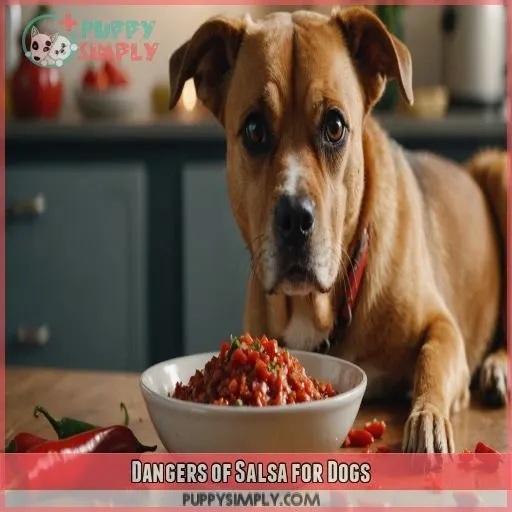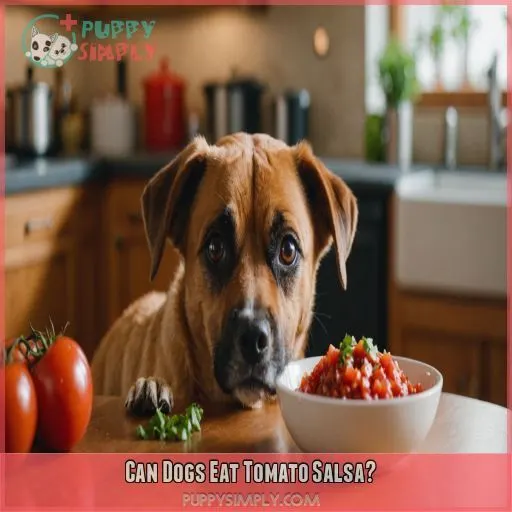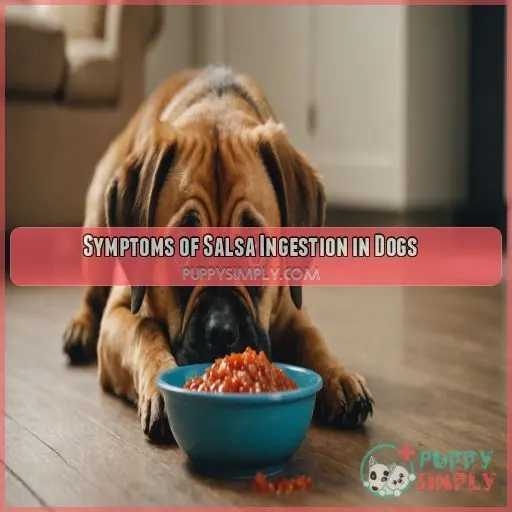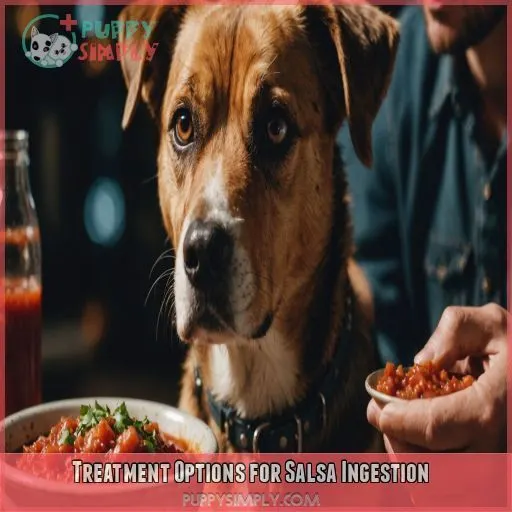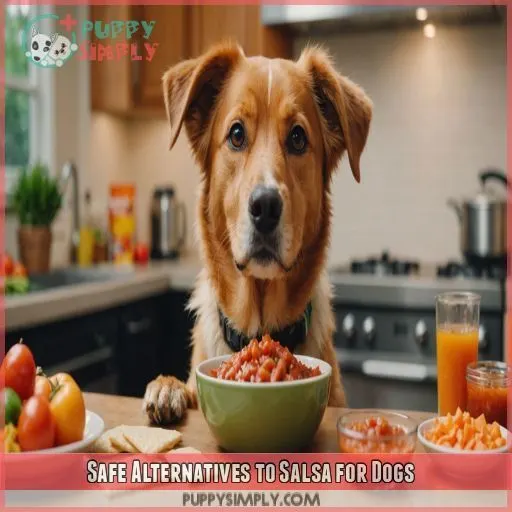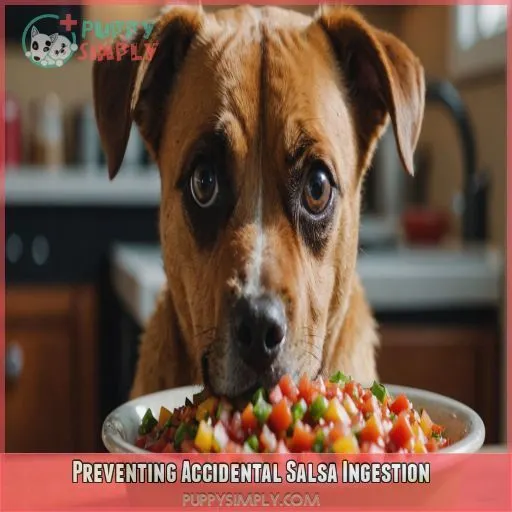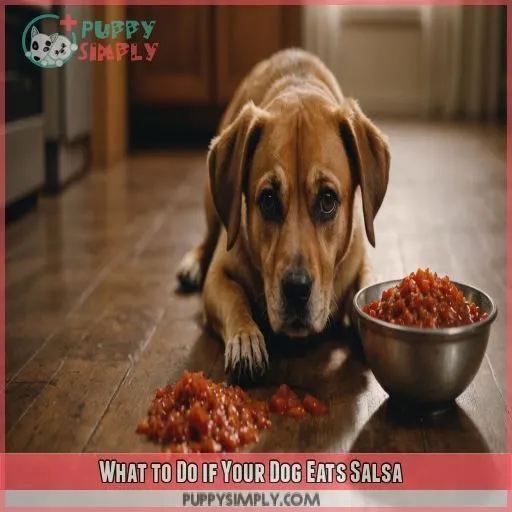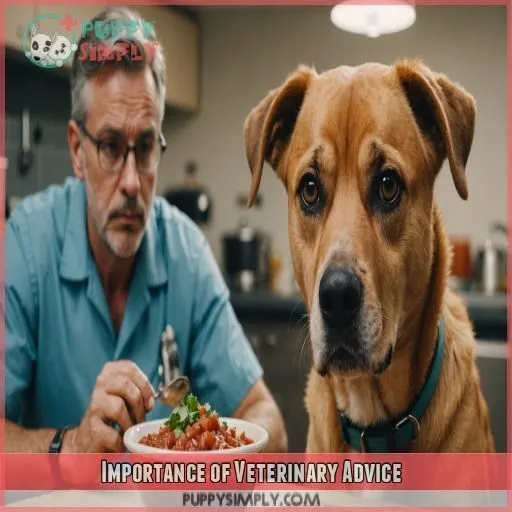This site is supported by our readers. We may earn a commission, at no cost to you, if you purchase through links.
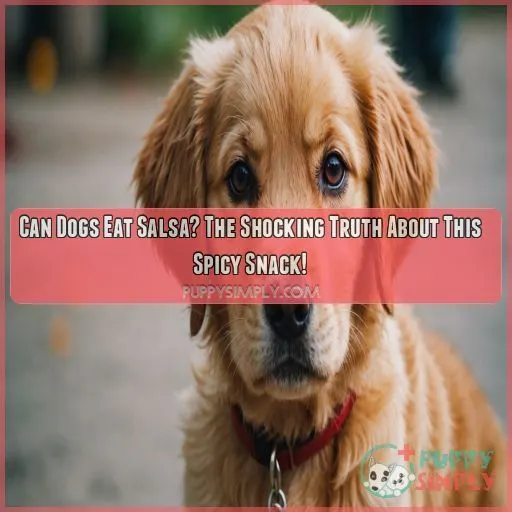 Can dogs eat salsa? Unfortunately, no.
Can dogs eat salsa? Unfortunately, no.
Salsa is a big no-no for your furry friend.
Onions and garlic in salsa can be toxic to dogs, causing vomiting, diarrhea, and even anemia.
And let’s not forget the jalapenos, which can lead to stomach upset and discomfort.
If your dog accidentally ingests salsa, monitor their behavior closely and seek veterinary attention if symptoms worsen.
Don’t worry, there are plenty of dog-friendly snacks out there – and we’re about to spill the beans on what they are, so your pup can stay safe and satisfied!
Table Of Contents
- Key Takeaways
- Dangers of Salsa for Dogs
- Can Dogs Eat Tomato Salsa?
- Symptoms of Salsa Ingestion in Dogs
- Treatment Options for Salsa Ingestion
- Safe Alternatives to Salsa for Dogs
- Preventing Accidental Salsa Ingestion
- What to Do if Your Dog Eats Salsa
- Importance of Veterinary Advice
- Frequently Asked Questions (FAQs)
- What happens if my dog ate salsa?
- Can dogs eat tomato salsa?
- Is spicy salsa bad for dogs?
- Can dogs eat tomato sauce from a can?
- Can dogs develop long-term health issues from salsa consumption?
- Is homemade salsa safer for dogs than store-bought versions?
- How does a dogs age affect salsa toxicity levels?
- Can some dog breeds tolerate salsa better than others?
- Will repeated exposure to small amounts of salsa harm dogs?
- Conclusion
Key Takeaways
- You’ll want to keep salsa out of your dog’s reach, as the onions and garlic in it can cause anemia and damage to their red blood cells—and even small amounts can be toxic.
- If your dog sneaks a snack of salsa, monitor their behavior closely for signs of illness, such as vomiting, diarrhea, or lethargy, and don’t hesitate to reach out to your vet for guidance.
- Instead of salsa, consider adding some dog-friendly flavor to their meals with ripe tomatoes or cilantro leaves—just be sure to introduce new foods slowly and in moderation.
- To avoid a potentially disastrous snack attack, store salsa in dog-proof containers, supervise your dog around food, and educate your family members on the risks of salsa for dogs—it’s always better to be safe than sorry!
Dangers of Salsa for Dogs
You’re probably wondering if it’s safe to share your favorite salsa with your furry friend, but the truth is, salsa can be a recipe for disaster for dogs. From onion toxicity to Jalapeno Pepper risks, there are several dangers lurking in this spicy snack that you need to know about to keep your pup safe.
Onion Toxicity in Salsa
Here’s the lowdown on onion toxicity in salsa for your furry friend: if your dog weighs 40 pounds, about 1/3 cup of pure onion can cause trouble. Keep an eye out for symptoms like loss of appetite, depression, and diarrhea, which may pop up days after ingestion. For peace of mind, stick to safe salsa substitutes or homemade alternatives.
Garlic Toxicity in Salsa
Here’s the lowdown on garlic toxicity in salsa for dogs: like onions, garlic can cause damage to your dog’s red blood cells, leading to anemia. Even small amounts can be toxic, so it’s best to keep salsa out of reach. If your dog ingests garlic, monitor their behavior and seek veterinary attention if symptoms arise.
Jalapeno Pepper Risks in Salsa
Now that we’ve covered garlic toxicity, let’s talk about jalapeno pepper risks in salsa. If your dog ingests jalapenos, the capsaicin can cause vomiting, digestive upset, and discomfort. Here are some key concerns:
- Jalapeno pepper heat can irritate your dog’s digestive system.
- Capsaicin effects can be intense, leading to vomiting and diarrhea.
- Even small amounts can cause stomach upset.
- Monitor your dog’s behavior and health closely.
- Consider safe alternatives to salsa to avoid these risks.
Other Harmful Ingredients in Salsa
When it comes to salsa, it’s not just the onions and garlic you need to worry about.
Other ingredients like lime juice, salt, and cilantro stems can also harm your dog.
Even small amounts of jalapeño seeds or garlic powder can cause problems.
Keep an eye out for signs of dog poisoning, and avoid giving your dog unripe tomatoes or tomato juice.
Can Dogs Eat Tomato Salsa?
You’re probably wondering if it’s safe to share your favorite tomato salsa with your furry friend. While ripe tomatoes are generally okay for dogs in moderation, tomato salsa can be a different story due to the added ingredients like onions, garlic, and jalapenos that can be toxic to dogs.
Tomato Safety for Dogs
When it comes to tomatoes, you can breathe a sigh of relief – ripe tomatoes are generally safe for dogs in moderation. However, you need to keep in mind that green tomatoes and tomato plants are toxic. Stick to plain, ripe tomatoes, and avoid giving your dog tomato sauce or other processed tomato products.
Risks of Tomato Salsa for Dogs
Onions and garlic in salsa can cause abdominal pain, and even small amounts can be toxic.
Ripe tomatoes are generally safe, but the acidity and solanine in unripe or green tomatoes can be problematic.
Keep a close eye on your dog if they’ve ingested tomato salsa, and consult your vet if you’re worried.
Safe Alternatives to Tomato Salsa
Now that you know the risks of tomato salsa for dogs, let’s explore some safe alternatives. You can try these dog-friendly options:
- Ripe tomatoes: Fresh, ripe tomatoes are safe for dogs in moderation.
- Cilantro leaves: Add a few cilantro leaves to your dog’s food for a fresh flavor.
- Homemade dog treats: Whip up a batch of homemade treats using safe ingredients like carrots and green beans.
Remember to always prioritize your dog’s safety and consult with a veterinarian before introducing new foods.
Symptoms of Salsa Ingestion in Dogs
If your dog has snagged a snack of salsa, you’re probably worried about what might happen next. Keep a close eye on your furry friend, because symptoms of salsa ingestion can range from mild tummy troubles to more serious signs of anemia, and it’s really important to catch any potential problems early.
Mild Gastroenteritis Symptoms
If your dog has eaten salsa, you’re likely to see mild gastroenteritis symptoms within 24 hours.
Keep an eye out for vomiting, diarrhea, and lethargy.
These symptoms usually pass on their own, but it’s important to watch your dog’s behavior and talk to a veterinarian if they get worse or don’t go away.
Home remedies like Pepcid can help soothe your dog’s stomach.
Signs of Anemia in Dogs
If your dog has eaten salsa, keep an eye out for signs of anemia, like pale gums, fatigue, and a lack of appetite. A blood test can confirm anemia, often caused by iron deficiency. Don’t panic, but do act quickly. Even small amounts of onion or garlic can trigger anemia, so monitor your dog closely.
Severe Symptoms of Salsa Ingestion
If your dog’s symptoms worsen, watch for severe signs of salsa ingestion, such as vomiting blood, diarrhea, lethargy, or difficulty breathing. Onion toxicity can cause anemia, which may lead to pale gums, rapid heartbeat, or collapse. If you suspect salsa poisoning, seek immediate vet consultation to prevent long-term damage to your dog’s health.
Treatment Options for Salsa Ingestion
If your dog has ingested salsa, you need to act quickly and carefully to minimize potential harm. In this section, we’ll walk you through the best treatment options for salsa ingestion, from home remedies to veterinary attention, so you can help your furry friend recover and stay safe.
Home Remedy Treatment Plan
If your furry friend has ingested salsa, don’t panic! You can try a home remedy treatment plan. Here are some steps to follow:
- Give your dog Pepcid (Famotidine) to alleviate gastroenteritis symptoms.
- Monitor their hydration levels closely.
- Consider adding probiotics to their diet to restore gut balance.
- Keep an eye on their recovery time and adjust the treatment plan as needed.
- Consult with your vet before making any dietary changes.
Dietary Rest and Recovery
Now that you’ve started treating your dog’s salsa mishap, it’s time for dietary rest. Starve your dog for 24 hours, but keep them hydrated with plenty of water. After the fast, reintroduce their normal food gradually. Consider adding probiotics to help restore gut balance. Monitor for vomiting or diarrhea and adjust their diet accordingly.
Veterinary Attention and Support
If your dog starts showing any of these symptoms after eating salsa, it’s time to take them to the vet:
- Vomiting
- Diarrhea
- Loss of appetite
- Lethargy
- Pale gums
In emergency situations, it’s really important to act fast. Keep your vet’s number handy, and don’t hesitate to call for advice. The vet might recommend a vet-recommended diet to help your dog’s tummy recover. Probiotics for dogs can also be useful in restoring gut balance.
Safe Alternatives to Salsa for Dogs
Worried your pup might snag your salsa? Fret not! There are safer alternatives to this spicy snack that your furry friend can enjoy. Discover tasty swaps like ripe tomatoes and cilantro leaves, plus other dog-approved treats to offer when you’re enjoying salsa.
Ripe Tomatoes as a Safe Snack
Ripe Tomatoes: A Tasty Treat for Dogs
Good news: ripe tomatoes are a safe and healthy snack for your pup! They’re packed with vitamins and antioxidants, offering benefits like improved vision and heart health. Just remember, moderation is key. Too much tomato can lead to an upset stomach. The serving size depends on your dog’s size, but one or two cherry tomatoes or a few slices of larger varieties are generally safe. Some dogs may have allergies, so introduce them slowly.
Cilantro Leaves as a Safe Addition
While salsa is a no-go for dogs, you might be wondering, can my dog eat those cilantro leaves? The answer is yes, in safe quantities. Those fragrant cilantro leaves can be a tasty addition to your dog’s dinner, but there are a few things to keep in mind:
- Safe Amounts: A few sprigs of cilantro leaves are fine, but don’t go overboard.
- Skip the Stems: Cilantro stems are a no-no. They can cause digestive issues, so stick to the leaves only.
- Monitor Their Reaction: Keep an eye on your pup after they’ve tried cilantro. Some dogs may have an upset tummy, so have that vet on speed dial.
- Mix Things Up: Add a little chopped cilantro to their regular dinner for a fresh twist.
Other Dog-Friendly Foods and Treats
Your furry friend has a world of safe, tasty treats to explore.
How about some steamed green beans, carrot sticks, or apple slices? These are healthy alternatives your pooch will love.
Go for dog-friendly snacks like peanut butter on celery or frozen yogurt drops.
Just remember, a balanced dog diet is key, so keep the treats in moderation!
Some healthy, store-bought options include brands like Canidae and Wellness.
Preventing Accidental Salsa Ingestion
You’re probably worried about your furry friend getting into the salsa, and for good reason – those tasty ingredients can be toxic to dogs. To avoid a potentially disastrous snack attack, it’s important to take steps to prevent accidental salsa ingestion and keep your pup safe.
Keeping Salsa Out of Reach
You love your furry friend, and you keep them safe. So, keep that salsa stored away! It’s a no-go for dogs, and they might sniff it out.
Think of it like child safety. Use dog-proof containers and smart kitchen organization to prevent a sneaky snack attack.
Keep salsa high up, in sealed containers, or in the fridge. Offer pet-friendly snacks instead. It’s a tasty treat for you, but toxic for them.
Supervising Dogs Around Food
When it comes to supervising dogs around food, you can’t be too careful.
Counter surfing is a real risk, especially with tantalizing treats like salsa within reach.
Keep human food out of bounds, and store dog food safely to avoid mix-ups.
Practice good food safety habits, and remember, kid safety is also a concern – little hands can easily drop food, putting your furry friend in harm’s way.
Educating Family Members on Salsa Risks
Here’s the lowdown: educate your family on salsa risks to prevent accidental ingestion. Make sure everyone knows that salsa is off-limits to your furry friend. Establish kitchen rules, like keeping salsa out of reach, and introduce kid-friendly snacks and dog-safe treats. By doing so, you’ll create a safer environment for both your pets and kids.
What to Do if Your Dog Eats Salsa
If your dog has just gobbled up some salsa, you’re probably freaking out – and rightly so. Keep a close eye on your furry friend and get ready to take action, because the next few hours are super important in ensuring their safety and well-being.
Monitoring Your Dog’s Behavior
If your dog eats salsa, monitor their behavior closely. Keep an eye out for signs of illness, such as diarrhea, vomiting, or lethargy. Here are some things to watch for:
- Diarrhea or loose stools
- Vomiting or regurgitation
- Lethargy or depression
- Loss of appetite or water intake
Act quickly if you notice any of these symptoms, and don’t hesitate to reach out for guidance.
Seeking Veterinary Attention
If your dog eats salsa, don’t panic! Monitor their behavior closely and seek veterinary attention if you notice any concerning symptoms like vomiting, diarrhea, or lethargy. Even if it’s just a small amount, it’s better to err on the side of caution. Your vet can provide guidance on the best course of action and help prevent any potential complications.
Providing a Safe and Balanced Diet
Now that you’ve sought veterinary attention, it’s time to focus on providing a safe and balanced diet for your furry friend. Here are some tips:
- Stick to reputable dog food brands or consider homemade dog food with balanced nutrients.
- Avoid raw diets or vegan dog food unless recommended by your vet.
- Gradually reintroduce your dog’s regular commercial dog food after a digestive upset.
Importance of Veterinary Advice
When your furry friend gets into something they shouldn’t, like salsa, it’s natural to panic – but before you do, take a deep breath and reach out to your veterinarian for advice. Consulting a vet can be a lifesaver, and it’s really important to get expert guidance on what to do next to keep your dog safe and healthy.
Benefits of Consulting a Veterinarian
When your dog eats salsa, it’s natural to panic. But before you freak out, consult a veterinarian for trusted advice. They’ll assess the situation and provide personalized guidance. Here’s why their expertise matters:
| Vet Expertise | Pet Health Benefits | Preventative Care |
|---|---|---|
| Toxicity assessment | Timely treatment | Avoids complications |
| Customized advice | Addresses specific needs | Makes sure a safe recovery |
| Emergency support | Provides peace of mind | Saves lives |
Your vet’s got your back – and your dog’s health. Reach out for professional help and breathe a sigh of relief.
Expert Verification and Credentials
When seeking veterinary advice, make sure the expert has verified credentials. Look for vet certification and a solid track record of experience. Online expert platforms like Just Answer can connect you with trustworthy resources. Don’t hesitate to ask about credential requirements – your furry friend’s health is worth it. Verify an expert’s credentials before taking their advice.
Frequently Asked Questions (FAQs)
What happens if my dog ate salsa?
If your dog ate salsa, monitor them closely for signs of illness, such as vomiting, diarrhea, or lethargy. Contact your vet for advice, as the amount and type of salsa consumed can impact the severity of the reaction.
Can dogs eat tomato salsa?
Coincidentally, you’re wondering if dogs can eat tomato salsa? While ripe tomatoes are safe for dogs in moderation, salsa contains onions, garlic, and other ingredients that can be toxic, so it’s best to keep it out of reach.
Is spicy salsa bad for dogs?
Is spicy salsa bad for dogs? Yes, it can be. The onions and garlic in salsa can cause anemia and damage to a dog’s red blood cells, even in small amounts, so it’s best to keep it out of reach.
Can dogs eat tomato sauce from a can?
Did you know 60% of pet owners consider their pets part of the family? For canned tomato sauce, it’s generally safe for dogs in small amounts, but always check with your vet to be sure.
Can dogs develop long-term health issues from salsa consumption?
If your dog consumes salsa, long-term health issues can arise if the amount eaten exceeds the toxicity threshold, especially if onions are present. Monitor your dog closely and consult a vet to prevent potential complications.
Is homemade salsa safer for dogs than store-bought versions?
It’s cool that 70% of pet owners consider their pets part of the family. Now, when it comes to homemade salsa, it’s not necessarily safer for dogs than store-bought versions, as both can contain toxic ingredients like onions and garlic.
How does a dogs age affect salsa toxicity levels?
Your dog’s age plays a significant role in salsa toxicity levels. Puppies, especially those under six months, are more vulnerable to onion toxicity due to their developing livers and kidneys, so it’s really important to be extra cautious.
Can some dog breeds tolerate salsa better than others?
While some breeds may be more resilient, it’s important to remember that salsa toxicity affects dogs across breeds. Focus on the amount and ingredients, not the breed, and always prioritize caution and consult your vet.
Will repeated exposure to small amounts of salsa harm dogs?
If your dog is sneaking salsa regularly, repeated exposure to small amounts can still cause harm. Onions and garlic in salsa can build up in your dog’s system, leading to anemia and other health issues over time.
Conclusion
Did you know over 60% of dog owners unwittingly feed their pets human food that can be toxic?
Can dogs eat salsa? Unfortunately, no.
With onions, garlic, and jalapenos posing serious health risks, it’s really important to keep this spicy snack out of reach.
Instead, opt for dog-friendly treats and consult your veterinarian for expert advice on keeping your pup safe and satisfied.

